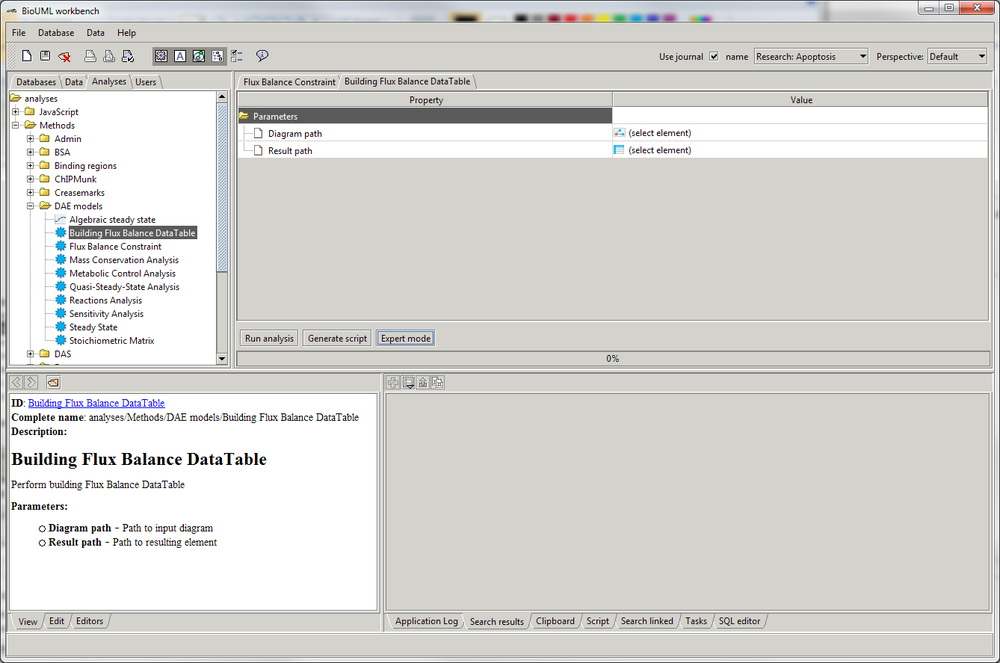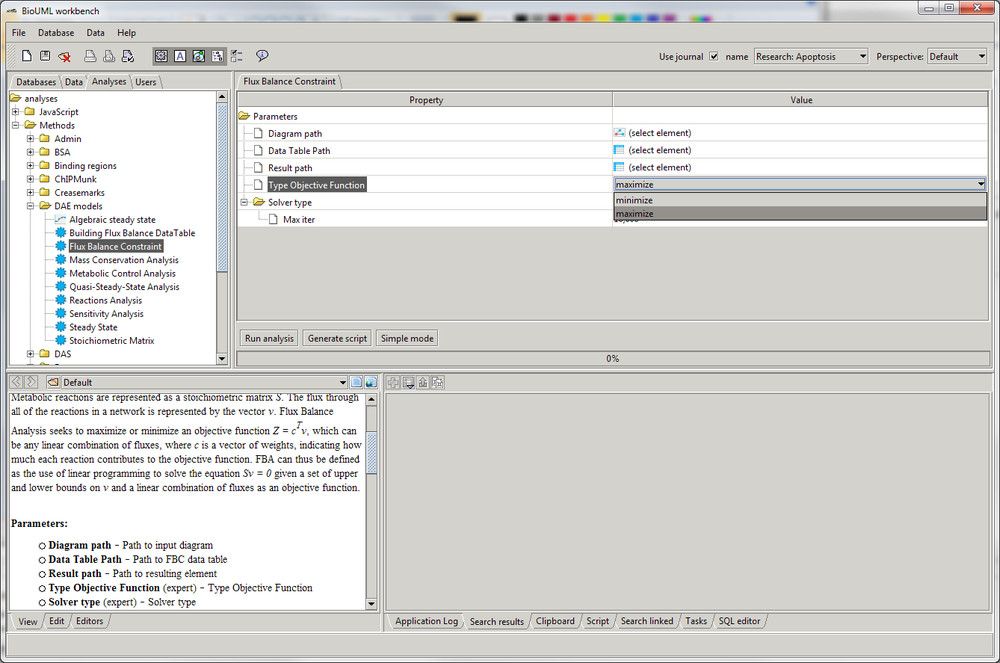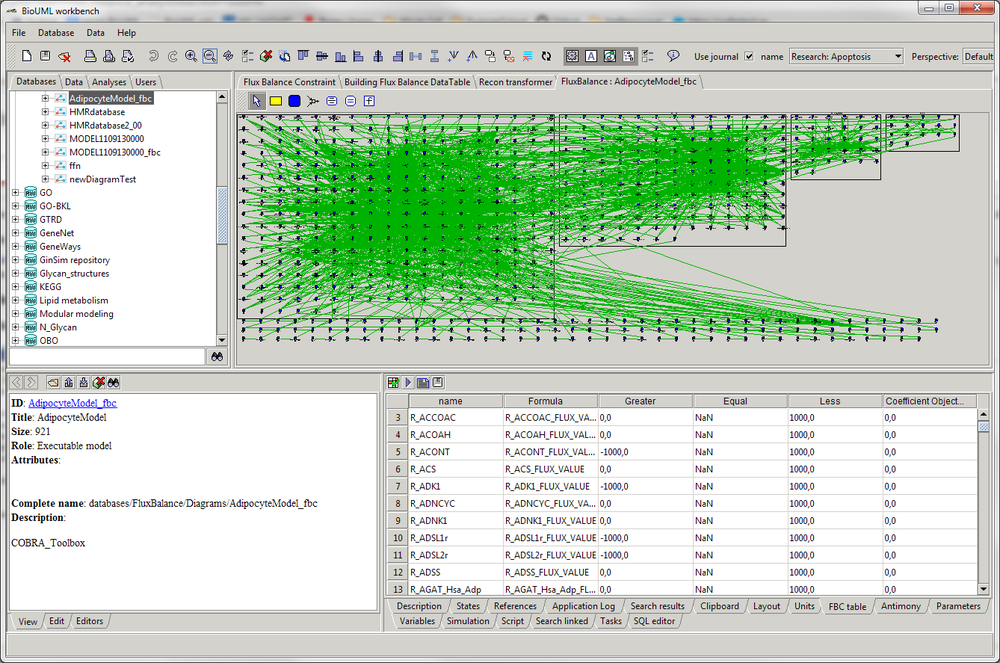Difference between revisions of "Flux balance analysis"
(→FBA via Analysis tab) |
(→FBA via Analysis tab) |
||
| Line 9: | Line 9: | ||
<font size="3"> | <font size="3"> | ||
FBA can be also conducted via the [[Flux Balance Constraint (analysis)|Flux Balance Constraint]] analysis in the [[BioUML]]. | FBA can be also conducted via the [[Flux Balance Constraint (analysis)|Flux Balance Constraint]] analysis in the [[BioUML]]. | ||
| − | + | Firstly, move to <b>Analysis</b> tab in the <b>Tree Area</b> by a single click with the right mouse button on the corresponding tab. | |
| − | + | <h3> FBC data table creation </h3> | |
| − | <span style="font-size: 90%"> '''Figure | + | To start the analysis via the tab it is required to create the table with flux balance constraint data. It can be created via [[Building Flux Balance DataTable (analysis)|Building Flux Balance Data Table]] analysis. |
| + | It is worth noting, that the [[Building Flux Balance DataTable (analysis)|Building Flux Balance Data Table]] analysis and "FBC table" tab work only with [[SBML (file format)|SBML]] L3v1 {{Type link|diagram}}s with special <b><i>fbc</i></b> package. Thus, if the {{Type link|diagram}} does not satisfy these conditions it should be transformed before using this analysis. For example, if the {{Type link|diagram}} does not use <b><i>fbc</i></b> package but contains all necessary information about fluxes, it should be preprocessed by [[Recon transformer (analysis)|Recon transformer]] firstly. | ||
| + | |||
| + | [[File:bfb1.png|1000px]] | ||
| + | |||
| + | <span style="font-size: 90%"> '''Figure 4.''' View of <b>Building Flux Balance Data Table</b> analysis.</span> | ||
</font size="3"> | </font size="3"> | ||
| + | |||
| + | |||
=== FBC analysis usage === | === FBC analysis usage === | ||
| Line 29: | Line 36: | ||
<span style="font-size: 90%"> '''Figure 3.''' Example of "FBC table" tab usage for Recon model.</span> | <span style="font-size: 90%"> '''Figure 3.''' Example of "FBC table" tab usage for Recon model.</span> | ||
| − | |||
| − | |||
| − | |||
| − | |||
| − | |||
| − | |||
| − | |||
| − | |||
| − | |||
| − | |||
</font size="3"> | </font size="3"> | ||
Revision as of 11:32, 16 March 2022
Constraint-based flux balance analysis (FBA) is a mathematical approach that enables to provide a holistic view of the cellular metabolism in pro- and eukaryotes and predict flux distribution in a global (on a genome-scale level) metabolic network both under a range of environmental conditions and genetic perturbations. The maximization of the biomass equation is typically used as an objective function of the model for FBA.
Contents |
FBA via Diagram
FBA via Analysis tab
FBA can be also conducted via the Flux Balance Constraint analysis in the BioUML. Firstly, move to Analysis tab in the Tree Area by a single click with the right mouse button on the corresponding tab.
FBC data table creation
To start the analysis via the tab it is required to create the table with flux balance constraint data. It can be created via Building Flux Balance Data Table analysis.
It is worth noting, that the Building Flux Balance Data Table analysis and "FBC table" tab work only with SBML L3v1 ![]() diagrams with special fbc package. Thus, if the
diagrams with special fbc package. Thus, if the ![]() diagram does not satisfy these conditions it should be transformed before using this analysis. For example, if the
diagram does not satisfy these conditions it should be transformed before using this analysis. For example, if the ![]() diagram does not use fbc package but contains all necessary information about fluxes, it should be preprocessed by Recon transformer firstly.
diagram does not use fbc package but contains all necessary information about fluxes, it should be preprocessed by Recon transformer firstly.
Figure 4. View of Building Flux Balance Data Table analysis.
FBC analysis usage
To start work with the Flux Balance Constraint analysis one needs a ![]() diagram and a special table with data about its fluxes (names, bounds, objective function coefficients, etc.). Analysis enables to select path to the
diagram and a special table with data about its fluxes (names, bounds, objective function coefficients, etc.). Analysis enables to select path to the ![]() diagram, to the data table and to the table with results. Also it has an expert mode where user can select type of the objective function, solver type (GLPK, Apache simplex solver and Gurobi solver are available) and some solver's properties.
diagram, to the data table and to the table with results. Also it has an expert mode where user can select type of the objective function, solver type (GLPK, Apache simplex solver and Gurobi solver are available) and some solver's properties.
Figure 2. Solver type selection in the FBC analysis.
If the ![]() diagram contains fluxes properties written as fbc extension of the SBML "FBC table" tab can be used. Advantage of this tab usage is lack of necessity in creation table with data about fluxes: it will be created automatically using
diagram contains fluxes properties written as fbc extension of the SBML "FBC table" tab can be used. Advantage of this tab usage is lack of necessity in creation table with data about fluxes: it will be created automatically using ![]() diagram.
diagram.
Figure 3. Example of "FBC table" tab usage for Recon model.


